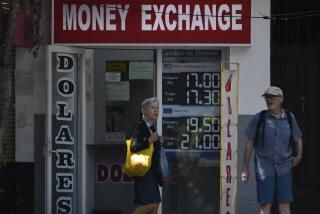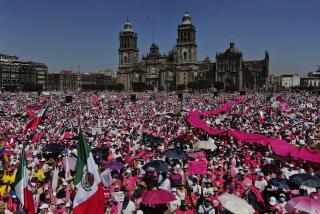Old Theories Fail, ‘Model Debtor’ in Bind
Latin America is suffering debt fatigue. Austerity has been pushed to the limits of popular tolerance, and most countries’ earnings are mortgaged to creditors for years to come.
The region’s new civilian governments’ responses to this grim reality shifted significantly in 1985. This was in part because of mounting tensions, as reflected in strikes, protests, street crime, insurgency, polls and several election outcomes. But it was also because the premises of established debt-management strategy came increasingly under challenge.
The conventional approach counts on expanding demand for developing nations’ exports and higher prices for their commodities, fueled by economic recovery and growth in the industrial countries. It also relies on decreasing interest rates as fiscal equilibrium is restored in the United States; on renewed voluntary lending by the commercial banks as Latin American countries restructure their economies; and on expanded foreign investment as the region’s growth prospects improve.
None of these expectations materialized to any degree in 1985, and the Reagan Administration finally came to realize that Latin America’s debt requires a long-term U.S.-coordinated response. In October, Treasury Secretary James A. Baker III offered a plan of action that endorsed the view held by Latin American economists: Growth through new outside investment, not sustained austerity, was most likely to bring the region’s debt down to size. In the words of Brazil’s President Jose Sarney, “Latin America can no longer accept abstract theories that condemn us to stagnation.”
The failure of orthodox debt strategy is exemplified in Mexico. Until 1985 Mexico had been seen as the model debtor; after two years of drastic austerity in 1982 and 1983, Mexico seemed on the road to full recovery in 1984, when it posted a growth rate of more than 3.5% and brought down inflation and the public deficit. The commercial banks arranged a multi-year rescheduling agreement that extended maturities to 14 years and made a number of other concessions, thus providing implicit incentives to other debtors to follow Mexico’s example.
Mexico’s progress could not be sustained in 1985, however. Growth fell back to little more than the rate of population increase, and was declining by the end of the year. Inflation, the reduction of which has been President Miguel De la Madrid’s priority, leveled off at 60%, still very high by Mexico’s historic standards. Capital flight soared to at least $2.5 billion for the year. The peso plummeted to a rate of more than 500 to the dollar in November, before recovering somewhat.
Mexico’s severe difficulties are due in part to a steady four-year decline in oil prices; 1985 petroleum earnings were about $2 billion below official projections. But much more than oil shock is involved. Non-petroleum exports also are down. Equally important, Mexico’s imports rose for the second consecutive year, for the Draconian cuts of 1983 could not be continued.
By last October, Mexico could not meet even its rescheduled debt-service obligations, which amounted to more than half of its 1985 export earnings; interest payments alone took almost 37% of export earnings. There was no relief in sight; on the contrary, the devastating September earthquakes further depressed tourism revenues and created major capital needs for reconstruction.
Mexico’s economic decline has exacerbated political deterioration. Disaffection with corruption and the remoteness of the ruling technocracy has grown, as has opposition to the ruling Institutional Revolutionary Party. The government has reacted by becoming both more repressive and more blatantly manipulative: Its decision to increase spending to influence the mid-1985 congressional elections only aggravated the country’s economic problems.
The political consensus that holds Mexico together has begun to fray, with De la Madrid increasingly under attack from both right and left. Critics from the business community (encouraged by some in the United States) fault the regime for leaving too much of the bloated public sector intact, for allowing the government deficit to climb again because of politically motivated spending, and for sending out mixed signals that discourage foreign investors. National populists, still a powerful segment of Mexico’s ruling coalition, assail De la Madrid for obeisance to foreign investors and international lenders, and for what they consider an obsessive concern with cutting inflation even at the expense of investment and social needs. Mexico’s labor movement also is restive; it is unlikely to acquiesce in harsher austerity measures, and will probably oppose any choice for De la Madrid’s successor who is as internationally oriented as he has proved to be.
Miguel de la Madrid is caught in an excruciating bind, with little room to maneuver. He looks to the United States for help, but it remains unclear what support will be provided, and whether it will be sufficient.
More to Read
Sign up for Essential California
The most important California stories and recommendations in your inbox every morning.
You may occasionally receive promotional content from the Los Angeles Times.










